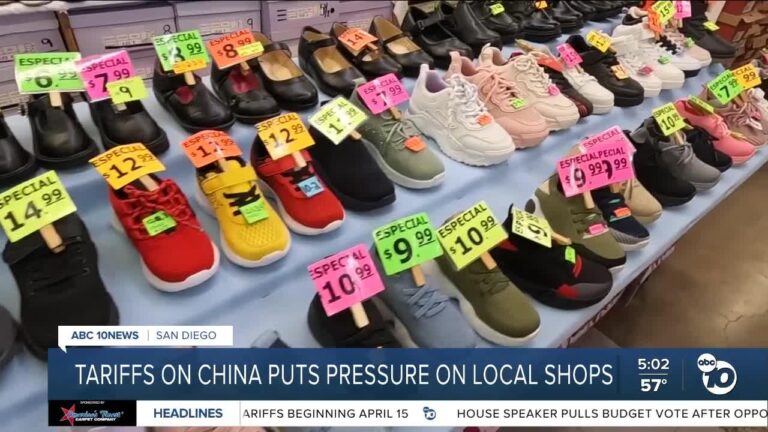Navigating Tariff Pressures: How San Diego Businesses Are Managing Rising Expenses
San DiegoŌĆÖs business community is bracing for the financial strain brought on by newly implemented tariffs amid ongoing global trade uncertainties. Many local entrepreneurs foresee that the increased costs of imported goods and raw materials will squeeze profit margins, potentially leading to higher prices for consumers. One local electronics store owner shared, ŌĆ£WeŌĆÖre caught between absorbing these extra costs, which would hurt our earnings, or passing them on and risking a drop in sales.ŌĆØ This unpredictability has caused many companies to pause expansion plans as they reevaluate supply chains and explore alternative sourcing to lessen the economic impact.
- Manufacturing Sector: Raw material prices have surged by as much as 15%
- Retail Industry: Struggling to maintain competitive pricing while managing cost increases
- Importers: Facing operational delays and higher compliance costs
| Industry Segment | Tariff-Driven Cost Increase | Adaptive Measures |
|---|---|---|
| Technology Hardware | 12% rise in expenses | Prioritizing local suppliers |
| Clothing Retailers | 18% hike on imported items | Adjusting inventory levels |
| Auto Parts Suppliers | 20% increase in material costs | Renegotiating supplier agreements |
Supply Chain Challenges and Their Consequences for San Diego Retailers
Retailers across San Diego are contending with significant supply chain disruptions that threaten profitability and inventory stability. The fluctuating trade environment has introduced erratic tariffs and shipping delays, compelling businesses to rethink their procurement strategies and cost management. Many retailers warn that these added expenses are likely to be reflected in consumer prices, affecting a wide range of products.
Primary obstacles confronting retailers include:
- Escalating costs: Tariffs on imports from major trading partners have driven up wholesale prices.
- Inventory bottlenecks: Delays in sea and air freight have slowed restocking efforts.
- Supplier diversification: Shifting to new suppliers to reduce risk often comes with higher costs.
| Challenge | Effect on Retailers | Likely Consumer Impact |
|---|---|---|
| Tariff Hikes | Product costs up by 15-25% | Increased retail prices |
| Shipping Delays | Inventory turnover slowed by 30% | Reduced product availability |
| Supplier Changes | Higher procurement expenses | Possible variations in product quality |
Effective Approaches to Reduce Tariff Burdens and Support Consumers
In response to tariff-induced financial pressures, San Diego businesses are adopting a variety of strategies aimed at minimizing cost increases while protecting their customer base. These include renegotiating contracts with suppliers, sourcing from regions unaffected by tariffs, and enhancing logistics efficiency to cut overhead. Such measures not only help sustain profit margins but also strive to prevent steep price hikes for consumers during economically challenging times.
Consumer advocates stress the value of transparency and clear communication. By openly sharing the reasons behind price changes, companies can build customer trust and manage expectations. Additionally, some retailers are implementing dynamic pricing strategies and loyalty programs to alleviate the financial impact on frequent buyers. The table below summarizes common tactics and their projected effectiveness based on recent market research:
| Strategy | Effectiveness | Impact on Consumer Pricing |
|---|---|---|
| Expanding Supplier Base | High | Moderate |
| Contract Renegotiation | Medium | Low |
| Optimizing Logistics | Medium | Low to Moderate |
| Customer Loyalty Programs | Low | Minimal |
Transparent Customer Communication: A Crucial Element for Building Trust Amid Tariff Uncertainty
As tariffs continue to challenge San Diego businesses, industry experts highlight the necessity of maintaining open and honest communication with customers. Transparent dialogue not only fosters trust but also helps manage consumer expectations as companies adjust prices and navigate supply chain hurdles.
Recommended communication practices include:
- Timely notification of any price changes along with clear explanations.
- Emphasizing efforts to control costs without sacrificing product quality or service standards.
- Providing alternatives or flexible options to ease the financial impact on customers.
| Communication Method | Business Advantage | Customer Benefit |
|---|---|---|
| Regular Email Updates | Improved customer engagement | Awareness of pricing changes |
| Social Media Transparency | Wider audience reach | Access to real-time information |
| Feedback Channels | Enhanced responsiveness | Customers feel valued and heard |
Looking Ahead: San Diego Businesses Prepare for Tariff-Driven Economic Shifts
As San Diego companies confront the evolving landscape shaped by new tariffs, many are gearing up for potential cost increases that may be reflected in consumer prices. The ongoing changes in trade policies continue to challenge local businesses striving to remain competitive and financially stable. Stakeholders remain vigilant, anticipating clearer regulatory guidance that could help alleviate the economic ripple effects impacting both enterprises and consumers in the near future.







